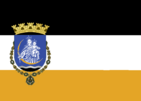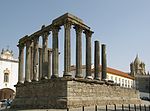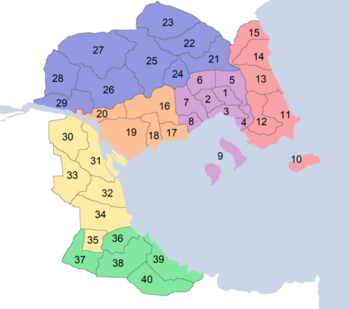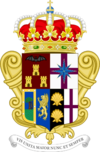Precea: Difference between revisions
| Line 174: | Line 174: | ||
[[File:Evora-RomanTemple edit.jpg|150px|thumb|left|The Solarian temple ruins in Precea]] Little is known about the area before the [[Solarian Empire]], other than {{wp|Celtic|Tenic}} tribes and [[Piraea|Piraean]] colonies inhabiting close by. The foundation of Precea is considered to be around 250 BC, many candidates are attributed to the founding of the city, many of which being [[Solarian Empire|Solarian]] generals. The most likely candidate is [[Tullus Viridius Paullus]], a Solarian general who commanded the Solarian forces in the province of [[Aureania Inferior]], modern day south [[Luzela]], around 256 to 205 BC. | [[File:Evora-RomanTemple edit.jpg|150px|thumb|left|The Solarian temple ruins in Precea]] Little is known about the area before the [[Solarian Empire]], other than {{wp|Celtic|Tenic}} tribes and [[Piraea|Piraean]] colonies inhabiting close by. The foundation of Precea is considered to be around 250 BC, many candidates are attributed to the founding of the city, many of which being [[Solarian Empire|Solarian]] generals. The most likely candidate is [[Tullus Viridius Paullus]], a Solarian general who commanded the Solarian forces in the province of [[Aureania Inferior]], modern day south [[Luzela]], around 256 to 205 BC. | ||
The area around Precea, the mouth of the [[Velox River]], was known as a resting point for Solarian military movements between [[Euclea]] and [[Coius]]. It is said that Solarian soldiers used the stop as a site for {{wp|praying}}, hence the name, which at the time was called ''Preceus''. The city at the time was small compared to other cities on the Paretian peninsula such as [[Mausoleu|Mausoleus]] and [[Chorto]]. | The area around Precea, the mouth of the [[Velox River]], was known as a resting point for Solarian military movements between [[Euclea]] and [[Coius]]. It is said that Solarian soldiers used the stop as a site for {{wp|praying}}, hence the name, which at the time was called ''Preceus''. The city at the time was small compared to other cities on the Paretian peninsula such as [[Mausoleu|Mausoleus]] and [[Chorto]]. It became a small trade hub due to it's vicinity to the [[Aurean Straits]]. | ||
===Verliqouian Empire=== | ===Verliqouian Empire=== | ||
Revision as of 23:49, 10 August 2021
This article is incomplete because it is pending further input from participants, or it is a work-in-progress by one author. Please comment on this article's talk page to share your input, comments and questions. Note: To contribute to this article, you may need to seek help from the author(s) of this page. |
Precea | |
|---|---|
Capital City | |
From top, left to right: View of Sobares Hill and the Bay of Precea • Arch of Unity at Tiago I Plaza • Luís Alves Bridge and Christo Rei da Precea • the Cathedral of Precea• Aurea Tower, the Precea Tramway, and Duarte Bórgia Bridge • Gomem Fortress • Florria Square • Primavera Palace the Palace of the Paretian Premier | |
| Nickname(s): the Golden Citadel, the Light of The East, the Sunrise City, the City of Prayers | |
| Motto(s): Omnes Audiuntur Huc "All are heard here" | |
| Country | |
| Constituent Kingdom | |
| Founded | 200-150 BC~ |
| Founded by | Solarian Empire |
| Freguesias | 40 Freguesias
|
| Government | |
| • Type | City |
| • Body | Council of Precea |
| • Mayoress | Roxana Alvim (Vs) |
| Population (2020) | |
| • Total | 3,243,102 |
Precea is the capital and largest city of Paretia. It has a population of just over 3.2 million people and growing. It is located just north of the Western Strait of the Aurean Straits and Montecara, on the eastern coast of Luzela, at the far eastern end of the Euclean Continent. It is the nation's cultural, political, and financial center. It has many nicknames that it is referred by in those in and outside of Paretia, such as the "Golden Citadel" (Cidadela Dourada), the "Light of The East" (Luz do Oriente), the "Sunrise City" (Cidade do Nascer do Sol), or the "City of Prayers" (Cidade das Orações).
Etymology
The name "Precea" comes from the original name of the city founded by the Solarians, Preceus. The name of Preceus comes from the Solarian word Preces, which means "prayers". The city of Preceus's naming derives from the location being a place where Solarian soldiers would stop during troop movements as a rest stop where many of the soldiers would use a site of praying.
History
Foundation and Solarian Empire
Little is known about the area before the Solarian Empire, other than Tenic tribes and Piraean colonies inhabiting close by. The foundation of Precea is considered to be around 250 BC, many candidates are attributed to the founding of the city, many of which being Solarian generals. The most likely candidate is Tullus Viridius Paullus, a Solarian general who commanded the Solarian forces in the province of Aureania Inferior, modern day south Luzela, around 256 to 205 BC.
The area around Precea, the mouth of the Velox River, was known as a resting point for Solarian military movements between Euclea and Coius. It is said that Solarian soldiers used the stop as a site for praying, hence the name, which at the time was called Preceus. The city at the time was small compared to other cities on the Paretian peninsula such as Mausoleus and Chorto. It became a small trade hub due to it's vicinity to the Aurean Straits.
Verliqouian Empire
Kingdom of Luzela

Early Modern

Industrialization

Great War
20th century
Modern
Government
The city has a special status as the capital and largest city of Paretia, but its government functions not much different from other major cities in the united kingdom. Today it serves as both the capitol of Luzela and Paretia, having both the administrations of the Kingdom of Luzela and the United Kingdom in the city.
The city's legislature is the city council, which has 10 members and works alongside the mayor. The city council and office of the mayor are ran at the Precea Administrative Building. Each with a two year term, they vote on laws and bills for the city.
The execvutive is the officer of the mayor, who leads the party with the most seats on the city council. They have a two year term and maintain the government of the city.
The judiciary is the Court of Precea. It deals with criminal and law cases in the city and has a judge that is appointed or voted in. This court runs the city's comarca.
Subdivisions
The city is divided into 6 regions, East, East Central, West Central, North, West, and South. These regions are further divided into 30 freguesias. East-Central is where the old city is located and is the city center. West-Central is where much of the financial district is located. The North and West regions are mostly populated with lower class to middle class people. The East and South regions are more upper class.
| |||||||||||||||||||||||||||||||||||||||||||||||||||||||||||||||||||||||||||||||||||||||||||||||||||||||||||||||||||||||||
Demographics
Culture
Sister Cities
|
|















